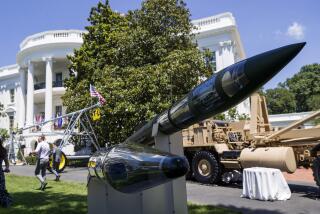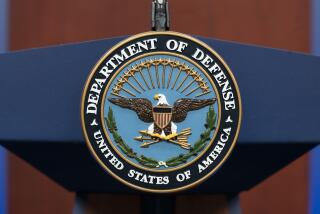Clinton Approves 38,000 Troops to Counter Iraq : Mideast: Hussein is continuing to mass forces near the Kuwaiti border, the President is told by advisers. The Pentagon also orders combat aircraft to the area.
- Share via
WASHINGTON — President Clinton, rushing to head off a continued Iraqi troop buildup that could presage another invasion of Kuwait, approved plans Sunday designed to send up to 38,000 U.S. ground troops--and hundreds of aircraft--to the region by the end of the week.
The decisions were disclosed after a meeting at the White House among Clinton and his top national security advisers at which the President was told that Iraqi President Saddam Hussein was continuing to mass more troops near the Kuwaiti border.
Defense Department officials said the additional troops to be sent would include the remainder of the 18,000-troop 1st Marine Expeditionary Force at Camp Pendleton, Calif., and the 16,000-soldier 24th Mechanized Infantry Division at Ft. Stewart, Ga.
Advance elements of both those units, made up of 300 Marines and 4,000 soldiers, left for Kuwait on Sunday.
Officials said the Pentagon still has not issued formal orders to deploy the rest but that the President has approved plans to do so early this week.
The Pentagon also ordered a spate of additional U.S. combat aircraft to Saudi Arabia, including 24 A-10 attack planes, 18 F-16 fighters and nine F-15C fighters, along with 14 C-130 transport aircraft from Pope Air Force Base in North Carolina.
And U.S. officials said Clinton is also considering options that include sending another, unspecified Army division made up of 16,000 more soldiers, B-52 bombers and F-117A Stealth fighters, which wreaked havoc on Iraqi forces during the Persian Gulf War.
The increase to 38,000 ground troops by the end of the week would mark the largest number of troops that the United States has deployed to the Persian Gulf region since the 1991 war. By comparison, Washington has about 20,000 soldiers and Marines in Haiti.
A senior defense official said Clinton’s immediate objective is to deter Iraq from invading Kuwait in a reprise of its 1990 incursion. If that effort fails, he said, the United States will use its forces to defeat the Iraqi forces as quickly and painlessly as possible.
Officials said U.S. intelligence reports showed that Iraq was continuing its buildup despite U.S. warnings over the weekend, with two divisions of Iraq’s elite Republican Guard pushing closer to the Kuwaiti border and other forces clearly on the move. Nearly 70,000 Iraqi troops are believed to be massing near the border.
They said satellite and air-reconnaissance photos had also shown that Iraqi forces were beginning to deploy a third division of the Republican Guard south to join the two others near the border--a move that would bring the total Iraqi force to more than 80,000 troops.
At the White House, National Security Adviser Anthony Lake told reporters that an estimated 16,000 of the Iraqi troops were poised within 1.2 miles of the demilitarized zone separating Iraq from Kuwait.
A senior defense official conceded that despite intensive reconnaissance efforts, U.S. analysts still have not determined for sure if Iraq intends to attack.
But he said that with these preparations, “Iraq could be ready in a matter of days . . . if it chooses.”
The latest U.S. moves intensified a drama that began last week, when Iraq began moving unusual numbers of troops toward the Kuwaiti border in what some U.S. analysts said was a bid to bully the West into easing post-Gulf War U.N. sanctions that have hurt Iraq’s economy.
Although the U.N. Security Council had been scheduled to vote on Baghdad’s appeal to lift the sanctions today, the United States had opposed the move, and the sanctions were expected to remain in force indefinitely.
Pentagon officials said the United States already has about 4,000 troops in Kuwait or offshore on amphibious warships. And, on Clinton’s order, the aircraft carrier George Washington, two Aegis cruisers, a destroyer and two submarines are heading toward the Gulf.
As Clinton reviewed Pentagon war plans, the Administration stepped up a major diplomatic effort to revive the allied coalition that joined with U.S. forces during the 1991 Gulf War, with officials consulting with their counterparts in Britain, France and other countries.
Meanwhile, Kuwait, which placed its forces on alert Friday, moved the bulk of its 18,000-member army up to the Iraqi border to help serve as a first line of defense if an invasion comes. And Saudi Arabia pledged cooperation in using its bases as staging areas.
For its part, Iraq said Sunday that it is seeking a diplomatic solution to the current crisis with the United Nations but asserted that it will insist on guarantees of a quick end to Gulf War sanctions.
Foreign Minister Mohammed Said Sahaf said in a statement carried by the Iraqi News Agency that France, China and Russia were working in that direction, but he warned that Baghdad would accept nothing short of assurances that “the suffering of the Iraqi people” would end.
Iraq also moved hundreds of people to the Kuwaiti border, apparently to stage demonstrations, according to U.N. officials. Iraq said they had been displaced after the Gulf War, but Kuwaiti officials said they were soldiers in civilian clothes.
The decision to increase the U.S. troop strength in the Persian Gulf area was accompanied by a round of stern warnings from top Administration officials, who took to the airwaves Sunday to caution Iraq that the United States means business.
“The main message . . . to Saddam Hussein is: ‘Do not make a mistake. Do not cross that border. Do not create circumstances that will force us to act,’ ” Madeleine Albright, the U.S. ambassador to the United Nations, said on CNN.
And Defense Secretary William J. Perry asserted that Iraqi forces would be roundly defeated if they tried to invade Kuwait. He also warned on the CBS-TV program “Face the Nation” that U.S. forces will attack--not just “sit there” waiting--if Iraq keeps its troops near the border indefinitely.
Secretary of State Warren Christopher, in Jerusalem to help spur the Arab-Israeli peace process, also raised the possibility that the United States might not pressure Israel to stay out of the war this time--as it did in 1991--if Iraq invades again.
Besides sending additional combat units, the Pentagon also sent two more highflying U-2 spy planes and two RC-135 reconnaissance aircraft to the region to enable U.S. intelligence officers to track the Iraqi force more closely.
Pentagon officials believe that Iraq is not likely to launch any invasion until later this week, after it has put into place the logistics arrangements that it will need to support a serious military action, and by that time U.S. forces should be in place to stop it.
The United States already had about 12,000 military personnel in the Persian Gulf region before the weekend’s increases were announced. These included 2,000 Marines on amphibious ships off Kuwait; 1,200 soldiers; 3,900 Air Force personnel; 4,600 sailors on naval vessels in the Red Sea and Persian Gulf, and 170 special operations troops.
Although intelligence officials concede they have no definite reading on why Hussein has ordered the troop buildup, they say Washington must prepare for the worst if it is to prevent him from invading Kuwait.
“You have to remember that the last time we received a very clear warning that he was developing a capability” and tried to guess his intentions, said Anthony H. Cordesman, a Georgetown University military analyst.
“The fact is that regardless of whom you talk to in the intelligence community, guess is the operative word,” he said. “When you have to guess, and when you have a demonstrated record of aggression, then you have no one but yourself to blame if you fail to react.”
Pentagon officials said the new U.S. troop deployments will be facilitated by contingency plans that the Pentagon developed after the Gulf War that called for “pre-positioning” huge amounts of weapons and equipment in the area, some on cargo ships.
The Marines from Camp Pendleton and the soldiers from Ft. Stewart will be flown to the Gulf area with only light combat gear and then “married up”--in Pentagon jargon--with tanks, Bradley fighting vehicles and other equipment now en route to the area.
The Pentagon has already sent several such “pre-positioned” cargo ships to the Gulf area, two of them from permanent berths at the Indian Ocean island of Diego Garcia and the rest continuously on station at sea.
Military commanders also sent two additional batteries of advanced Patriot air-defense missiles--with about 170 soldiers in total--to Kuwait on Friday. An earlier version of the Patriot was used to help knock down Iraqi Scud missiles in 1991, with mixed results.
Times staff writers John M. Broder in Washington and Norman Kempster in Jerusalem also contributed to this report.
More to Read
Sign up for Essential California
The most important California stories and recommendations in your inbox every morning.
You may occasionally receive promotional content from the Los Angeles Times.










